Ramses Ii
 From Conservapedia
From Conservapedia 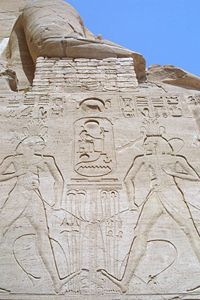
Ramses II (also referred to as Ramesses II), was a pharaoh of Egypt who died in 1213 BC. Ramesses II lived during the latter half of the New Kingdom, and he became known as Ramesses The Great as the most prominent ruler of the 19th Dynasty. At the time of his death, he had fathered at least 40 sons and 44 daughters.
Contents
- 1 Background
- 2 Military Campaigns
- 3 Diplomacy
- 4 Building Projects
- 5 Deification
- 6 Legacy
- 7 Modern Perceptions
- 8 Bibliography
Background[edit]
Ramesses II ascended to the throne in circa. 1279 BC, and ruled for 67 years, until circa 1213 BC, giving him the longest reign of the New Kingdom, and the longest since the reign of Pepi II of the 6th Dynasty. He was the son of Seti I, who preceded him on the throne, and a direct descendent of Ramesses I, the founder of the 19th Dynasty in peaceful succession.
During his long reign he married numerous wives, including a Hittite princess, though his principle wife was Nefertari, to whom he dedicated a temple in Abu Simbel, alongside his own. According to some sources, he may hav had well over 100 sons, 12 of whom predeceased him. He died aged 91, having becoming a full god in his own right, within his own lifetime, and having celebrated at least a dozen Sed festivals. He was succeeded by his 13th son, Merenptah.
Military Campaigns[edit]
The Battle of Kadesh is the most well known military campaign of Ramesses II, and the most well documented. Although regarded as a personal triumph by Ramesses, and proudly displayed upon numerous monuments throughout Egypt and Nubia, the battle itself ended in a stalemate, and the lands of Upe and Amurru were lost to the Hittites. The campaign was, however, only one of many conducted by Ramesses in his 67-year reign. The table below provides more complete detail of his major campaigns:
| Years | Location | Opponents | Outcome |
|---|---|---|---|
| 4 | Phoenecia and Southern Amurru | Benteshina, Hittite Vassal | Successful. Benteshina defeated, informs Hittites has had to become an Egyptian vassal. |
| 5 | Kadesh, Amurru | Hittite Alliance | Near defeat turned into stalemate at Kadesh. Following Egyptian return to Egypt, Hittite forces take Amurru and Upe. |
| 6 | Libya | Nomads | Border policing, possibly treated as a “test-run” for rebuilt forces. |
| 7/8 | Phoenician Coast, Edom, Moab and Amurru | Rebel vassals in Phoenicia, Shasu nomads, Hittite vassals | Rebel vassals pacified. Shasu infiltrators expelled, Edom and Moab temporarily become Egyptian vassals and some of Amurru accepts Egypt as overlord, but switches back to Hittites after campaign finishes. |
| 8/9 | Northern Amurru | Hittite Vassals | Capture of Tunip and Dapur, secures middle section of the Orontes, cutting of southern Amurru and Kadesh. Cities become Egyptian vassals, but return to Hittite control after Egyptian campaign forces depart. |
| 10 | Northern Amurru | Daput | Daput again conquered, recognises Ramesses as overlord. Returns to Hittite control once campaign forces depart. |
| 21 | n/a | n/a | Egyptian - Hittite Peace Treaty |
| ~38 | Irem | Local Chiefs | Successful. 7,400 captives taken, and rebel chief of Akuyata defeated and captured. Region essentially pacified for remainder of Ramesses’ reign. |
| 44 | Irem | Local Population | Minor policing action. |
Diplomacy[edit]
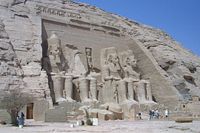
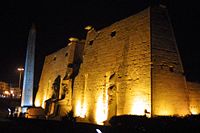
In his regnal year 21, Ramesses concluded a formal peace with the Hittite empire, following decades of sporadic tit for tat actions in the Levant that had brought no lasting gains for the Egyptians, despite temporarily extending the Egyptian sphere of influence into the new states of Moab and Edom east of the Jordan river. The peace treaty is one of the most famous of the ancient world, the text of which was delivered on a silver tablet to the Egyptians. Ramesses had it translated into Egyptian, and carved in hieroglyphs, complete with a description of the tablet, onto the walls of Karnak temple, where it can be seen today.
It was the first formal peace treaty entered into by the Egyptians (though a friendship and de facto alliance had existed between the Pharaohs of the Mittani during the 18th Dynasty). Later in his reign, negotiations with the Hittites led to Ramesses taking a Hittite princess as a secondary wife, strengthening relations between the two empires.
The peace treaty and friendship established by Ramesses far outlived his own reign, and brought a lasting and stable peace between the two great powers of the time, allowing Ramesses to devote his resources away from military campaigns and security in his vassal states, and into his ambitious building programme.
Building Projects[edit]
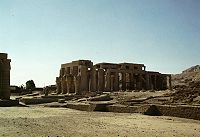
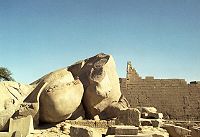
Ramesses built more extensively than any other Pharaoh. His major building projects spanned the length of Egypt and deep into Nubia, though he also erected stelae and statues in Asia. Many of his monuments survive today as some of the most famous images of Egypt, including the temples of Abu Simbel and the Ramesseum. He also completed the main pylon of Luxor Temple and the hypostyle hall of Karnak temple, begun by Seti I, as well as completing the mortuary temple of the latter.
However his most notable achievements are less visible, including the construction of the new royal residence, the city of Pi-Ramesse, adjacent to the city of Avaris, which effectively became the southern district of the new city. It has been estimated by Uphill that Pi-Ramesse once boasted multiple temple complexes, some on a scale approaching that of Karnak itself, sporting colossal statues equivalent in size to that of the Ramesseum, the largest known free standing statue to have been carved in Egypt, standing over 60 feet high.
Elsewhere, large scale additions were made to the temple of Ptah at Memphis (from where another colossal statue survives), Heliopolis, and almost all cities throughout Egypt saw work by him.
Ramesses also usurped earlier monuments, replacing the names of earlier Pharaohs with his own, as well as “recycling” architectural elements from old buildings into his own projects, including Pi-Ramesse, which was itself “recycled” to embellish the cities of Tanis and Bubastis in the 21st and 22nd Dynasties.
Deification[edit]
Ramesses became a complete god in his own right, within his own lifetime. Although the Pharaoh was by nature a divine being (see Pharaoh), the deification of a Pharaoh in his own right as an independent god was a rare occurrence, the result of a reign that was regarded as particularly significant of successful. Ramesses’ divinity is proclaimed most spectacularly at his Abu Simbel temple, nominally dedicated to Ra but where the fully divine Pharaoh is most often and widely depicted, not least in his four colossal statues (compared to a single smaller image of Ra, whose image actually forms a rebus of Ramesses own name). Here is depicted with the ram horns of Amun, and is depicted making offerings to his divine self.
Legacy[edit]
Ramesses legacy was a victim of his own success, for his longevity and large family meant that many of the more notable elder royal princes predeceased him, and his highly unusual style of bringing the royal prices out into the open, having them depicted in numerous scenes may well have fostered competition amongst hopefuls, further undermining an orderly succession and peaceful reign by his successors. Indeed, following Ramesses II were a string of ephemeral Pharaohs with short and insignificant reigns, and it was not until Ramesses III that another great Pharaoh emerged who could truly be said to be following in the footsteps of the Ramesses the Great.
In some ways it could be said Ramesses reign was the high point of latter (post–Amarna) New Kingdom, and though Ramesses III and many others strove to defend the boundaries of the Empire and embellish the great temples, the battles post – Ramesses II became less a case of “extending the boundaries of Egypt” and increasingly defensive in nature. Despite this, the vigorous efforts of Ramesses II to rebuilt the “New Kingdom” following the Amarna heresy would endure for more than 150 years, and his name became synonymous with Pharaonic greatness and power, with no less than nine Pharaohs adopting his name as their own in the 20th Dynasty, and the name remaining a popular Coptic name to this day.
Modern Perceptions[edit]
Ramesses reputation in modern times is often shaped by the poem “Ozymandias” by Shelley, where he writes, fictitiously, of a statue in the desert:
"I met a traveller from an antique land,
Who said: Two vast and trunkless legs of stone
Stand in the desert. Near them, on the sand,
Half sunk, a shattered visage lies, whose frown
And wrinkled lip and sneer of cold command,
Tell that its sculptor well those passions read,
Which yet survive stamped on these lifeless things,
The hand that mocked them, and the heart that fed;
And on the pedestal these words appear:
'My name is Ozymandias, King of Kings;
Look on my works, ye mighty, and despair!'
Nothing beside remains. Round the decay
Of that colossal wreck, boundless and bare
The lone and level sands stretch far away."
The piece was written in honor of the arrival in the British Museum of the upper portion of a colossal statue of the Pharaoh from the Ramesseum. However, in the statue itself, as with most Egyptian royal sculpture (see: Egyptian Art), Ramesses is shown with a serene composure, and a slight smile. It is one of the most well known pieces of Egyptian art, notable for it’s masterful use of polychromatic stone, which is seen elsewhere in sculpture of Ramesses II.
Other well known modern depictions of Ramesses include Hollywood movies, including the “epic” film production “The Ten Commandments”, where Ramesses is portrayed as a scheming megalomaniac and caricature of evil. An animated film following roughly the same biblical plot was produced in the 1990s by SKG-DreamWorks, though in this Ramesses was portrayed as a brother divided by loyalties who wanted to regain a lost childhood friendship.
The Egyptologist and writer Christian Jacq penned a series of five historical novels featuring Ramesses, one of which focuses on the Battle of Kadesh.
Bibliography[edit]
- Dodson, A and Hilton, D (2004), The Complete Royal Families of Ancient Egypt, Thames and Hudson, London
- Kitchen, K A (1982), Pharaoh Triumphant – The Life and Times of Ramesses II, Aris and Phillips, Warminster
- Kitchen, K A (1999), Ramesside Inscriptions Vol. II – Ramesses II Royal Inscriptions, Blackwell Publishers, Oxford
- Manley, B (1994), The Penguin Historical Atlas of Ancient Egypt, Penguin, London
- Quirke, S (2001), The Cult of Ra, Thames and Hudson, London
- Shaw, I and Nicholson, P (2008), The British Museum Dictionary of Ancient Egypt, British Museum Press, London
- Uphill, E P (1984), The Temples of Per-Ramesses, Aris and Phillips, Warminster
- Uphill, E P (1988), Egyptian Towns and Cities, Shire Publications, Princes Risborough
- Van Dijk, J (2000), The Amarna Period and the Later New Kingdom in: Shaw, I (Ed), the Oxford History of Ancient Egypt, Oxford University Press, Oxford
Categories: [Pharaohs]
↧ Download as ZWI file | Last modified: 02/28/2023 22:02:21 | 13 views
☰ Source: https://www.conservapedia.com/Ramses_II | License: CC BY-SA 3.0
 ZWI signed:
ZWI signed: KSF
KSF